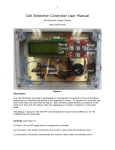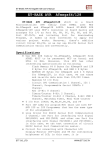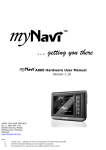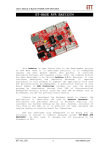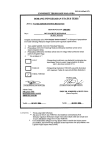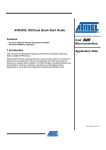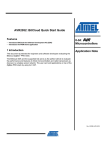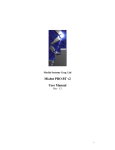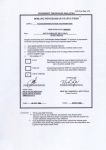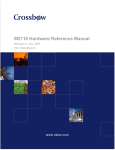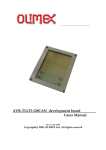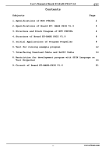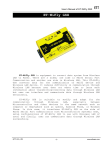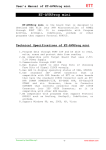Download Manual of ET-BASE AVR ATmega64-128 r3
Transcript
User’s Manual of ET-BASE AVR ATmega64/128 r3 ET-BASE AVR ATmega64/128 r3 ET-BASE AVR ATmega64/128 r3 is AVR Board Microcontroller from ATMEL that uses 64Pin MCU No.ATmega64 and No.ATmega128. It mainly emphasizes on using resources of MCU on this Board ET-BASE AVR ATmega64/128 r3. I/O Pins are externally connected to be Port PA, PB, PC, PD, PE, PF and Port ET-CLCD; so, it is more convenient to connect, and including Port for downloading program. Moreover, it adds Circuit Line Driver RS-232 to increase the capability of RS232 Serial Port Communication easier and more convenient. Features of Board • • • • • • • Use 8Bit AVR MCU No.ATmega64, ATmega128 from ATMEL and use Signal Clock Generator as XTAL 16MHz. Moreover, there are other outstanding features of MCU as follows; Has 64Kbyte Flash Memory for ATmega64, 128Kbyte Flash Memory for ATmega128 and 4Kbytes RAM Has 2Kbyte EEPROM for ATmega64 and 4Kbyte EEPROM for ATmega128; can be re-written more than 100,000 times Has a maximum of 53 I/O Pins Has 1-Channel SPI, 1-Channel I2C, 2-Channel Programmable Serial USARTs Has 8-Channel 10-Bit ADC Has 2-Channel 8-Bit Timers/Counters, 2-Channel 16Bit Timers/Counters, 2-Channel 8-Bit PWM, Watchdog Timer, Real Time Counter Has 6 of 10PIN I/O PORTs: PA,PB,PC,PD,PE,PF Has Port ISP LOAD for programming MCU (has to use with ET-AVR ISP of other ISP Programmers that has the same pin arrangement) Has Circuit Line Driver 2-Channel for RS232 Serial Port Communication; one channel is connected with Signal PE0(RXD0) and PE1(TXD0); and other one is connected with PD2(RXD1) and PD3(TXD1); so, user can connect with RS232 easily. Has circuit to connect with Character LCD Display (ETCLCD) and VR to adjust contrast or brightness of LCD; circuit is connected with 4Bit Interface LCD. Has Circuit +5V/2A Regulate to be Power Supply for Circuit LCD Display and I/O Devices that are compatible with +5V Power Supply, including red LED to display the operating status. Be small PCB Size: 8 x 6 cm. ETT CO.,LTD -1- www.etteam.com User’s Manual of ET-BASE AVR ATmega64/128 r3 Structure of Board • • • • • • • • • • • • • • • • • No.1: It is AVR MCU No.ATmega64 or ATmega128 from ATMEL. No.2: It is Switch RESET to reset the operation of MCU. No.3: It is Crystal 16MHz. No.4: It is VR to adjust contrast or brightness of LCD. No.5: It is Port AVR ISP(6PIN) to download HEX File into MCU. No.6: It is Port AVR ISP(10PIN) to download HEX File into MCU. No.7: It is 8Bit PORTC that is PC0-PC7. No.8: It is 8Bit PORTA that is PA0-PA7. No.9: It is 8Bit PORTF that is PF0-PF7. No.10: It is 8Bit PORTE that is PE0-PE7. No.11: It is 8Bit PORTB that is PB0-PB7. No.12: It is 8Bit PORTD that is PD0-PD7. No.13: It is Port ET-CLCD to connect with Character LCD that is 4Bit Interface. No.14 and 15: It is Connector RS232 for general use. No.16: It is Jumper to choose between RS232 or Port I/O. No.17: It is Connector Power Supply for board. No.18: It is LED Power to display the operating result of +5VDC Power Supply. ETT CO.,LTD -2- www.etteam.com User’s Manual of ET-BASE AVR ATmega64/128 r3 Connectors It has designed and arranged Connectors of Port I/O from MCU through 6 of Connectors IDC-Header 10PIN (2x5) that are PA, PB, PC, PD, PE, and PF respectively. Connectors in each set consist of Signal I/Os that are directly connected from Pin of MCU. The connecting points that are used to interface with external signal are listed below; • Connector Power Supply for board • Connector 8Bit PORTA that is PA0-PA7 • Connector 8Bit PORTB that is PB0-PB7 • Connector 8Bit PORTC that is PC0-PC7 • Connector 8Bit PORTD that is PD0-PD7 • Connector 8Bit PORTE that is PE0-PE7 • Connector 8Bit PORTF that is PF0-PF7 • Connector ET-CLCD to connect with Character LCD • 2-Channel Connector RS232; one channel is connected with PE0(RXD0) and PE1(TXD0); and other one is connected with PD2(RXD1) and PD3(TXD1); so, user can connect with RS232 easily. • Connector AVR ISP to download HEX File into MCU 8BIT PORT PA 8BIT PORT PB ETT CO.,LTD -3- www.etteam.com User’s Manual of ET-BASE AVR ATmega64/128 r3 8BIT PORT PC 8BIT PORT PD 8BIT PORT PE 8BIT PORT PF ETT CO.,LTD -4- www.etteam.com User’s Manual of ET-BASE AVR ATmega64/128 r3 Port AVR ISP Figures display circuit to connect with AVR ISP. Port ET-CLCD: It is used with Character LED as 4Bit Interface and it uses signals from Port PG and PD(PD7) to connect with LCD. It connects Cable from Connector of Port LCD to LCD Display; in this case, it uses the pin names to be the reference point; so, all 14 Cables must be agreed with all 14 pin names. ETT CO.,LTD -5- www.etteam.com User’s Manual of ET-BASE AVR ATmega64/128 r3 1 2 3 GND +VCC VO 4 5 6 RS RW EN Figure displays standard type. how to 7 D0 8 D1 arrange 9 D2 pin 10 D3 of 11 D4 12 D5 Character 13 D6 14 D7 LCD as 2-Channel Port RS232: There are 2 channels; one channel is connected with Signal PE0(RXD0) and PE1(TXD0); and other one is connected with Signal PD2(RXD1) and PD3(TXD1). ETT CO.,LTD -6- www.etteam.com User’s Manual of ET-BASE AVR ATmega64/128 r3 Figure displays the part of circuit that is connected with RS232. How to download HEX File into MCU If user requires download HEX File into AVR MCU of ATMEL through Serial Programming, it has to use ET-AVR ISP or other ISP Programmers such as AVRISP of AMTEL. If using ET-AVR ISP, it downloads HEX File through Parallel Port of computer; moreover, it has to use with ET-CAP10P of ETT and Software PonyProg200. This PonyProg2000 is the program to download HEX File data into AVR CPU through Serial Programming and is compatible with AVR Board from ETT well. User can read more information about general use of program from Help of Program by self. In this case, we will mention about how to setup Program PonyProg2000 to use with AVR Board from ETT; moreover, it is compatible with all AVR Boards from ETT. ETT CO.,LTD -7- www.etteam.com User’s Manual of ET-BASE AVR ATmega64/128 r3 Structure of Board ET-AVR ISP • • • • No.1: It is Port for interfacing with ET-CAP10P of ETT to program HEX File into MCU. No.2: It is LED PGM (Green) to display the status of programming or downloading HEX File into MCU. No.3: It is LED PWR (Red) to display the operating status of Power Supply for board. No.4: It is Port to connect with Target Board that can program HEX File into board ET-BASE AVR ATmega64/128 r3 by plugging Board ET-AVR ISP in Port AVR ISP. It arranges pins as shown in the picture below; Pin Position 1 2 3 4,6,8,10 5 7 9 ETT CO.,LTD -8- Signal Name MOSI VCC Unused GND RESET SCK MISO www.etteam.com User’s Manual of ET-BASE AVR ATmega64/128 r3 How to connect devices to program HEX File If user requires programming HEX File Code into AVR MCU, it has to use with ET-CAP10PIN and Program PonyProg2000. It connects ET-CAP10PIN with Printer Port; sets Jumper for using with Program PonyProg2000; connects Cable Download at Connector AVR ISP Download of board; and then supplies power into the board completely. If there is any external device is connected with Port PB, user has to remove it from the port first. The connection’s feature is shown in the picture below; (Left) ET-CAP10P V2.0 (Right) ET-CAP10P V1.0 Picture shows how to set Jumper and interface Cable Download of ET-CAP10P for using with AVR. ETT CO.,LTD -9- www.etteam.com User’s Manual of ET-BASE AVR ATmega64/128 r3 Picture shows how to connect ET-AVR ISP with ET-BASE AVR ATmega64/128 r3 by connecting both boards together. Please look at position of PIN 1, it must agree. How to program Board ET-BASE AVR ATmega64/128 r3 by Program PonyProg2000 Program PonyProg2000 is the program to download HEX File Data into AVR CPU through Serial Programming and it is compatible with AVR Board from ETT well. User can read more information about general use of program from Help of Program by self. In this case, we will mention about how to setup Program PonyProg2000 to use with AVR Board from ETT; moreover, it is compatible with all AVR Boards from ETT. Please be careful in using AVR CPU No.ATmega64/128, there are many Fuse Bits internal structure of ATmega64/128 that are used to set conditional operations of CPU. Some Fuse Bits have effect on Serial Programming Download; if user sets these Fuse Bits wrongly, it is unable to program any CPU by Serial Programming any more. In this case, user needs to edit these Fuse Bits by Parallel Programmer correctly first. If using Program PonyProg2000 to program AVR CPU that is used with ETT Board, it needs to set Option of program as follows; ETT CO.,LTD -10- www.etteam.com User’s Manual of ET-BASE AVR ATmega64/128 r3 1. Click Setup → Interface Setup… as follows; - Set I/O Port as Parallel and the Programming type as Avr ISP I/O - Set Printer Port according to actual connection; for example, LPT1 if using with Printer Port LPT1 - Do not set any value in the part of Polarity Control Line - Setup only one time when using the program in the first time 2. Set Program PonyProg2000 to calculate the proper speed for transmitting signal to program CPU, click Setup → Calibration. - ETT CO.,LTD Calibration only one time program in the first time -11- when using the www.etteam.com User’s Manual of ET-BASE AVR ATmega64/128 r3 3. Set CPU number, click Device → AVR Micro → Atmega64 or ATmega128 4. Click Command → Security and Configuration Bits. If it is other AVR numbers, user can set the operation of Fuse Bit as required and user can read more information of the Fuse Bits from Data Sheet of CPU by self. If using with ATmega64/128, please be careful in setting Fuse Bits correctly, otherwise user cannot program any CPU through Serial Programming any more. After set values as shown in the picture completely, click Button Write. (This process has been done only one time and user can skip this process when entering later. If using Board ET-BASE AVR ATmega64/128 r3, it is unnecessary to do this process again because ETT has already set the values, except user requires changing the value.) Picture displays No.ATmega64/128. ETT CO.,LTD how to set -12- Fuse Bit to use with CPU www.etteam.com User’s Manual of ET-BASE AVR ATmega64/128 r3 Meaning of Fuse Bits of ATmega64/128 If ticked [√] in front of any Fuse Bit, it means that it sets the Fuse Bit to be “0” or it programs the Fuse Bit. If did not tick [√] in front of any Fuse Bit, it means that it sets the Fuse Bit to be “1” or it does not program thee Fuse Bit. Meaning of Fuse Bits of ATmega64/128 that has effect on Serial Programming • • • • SPIEN: It is Serial Programming Enable Bit and user always sets this Fuse Bit because it is able to download program into CPU through In-System Serial Programming. Normally, this Fuse Bit has been set from the factory and it cannot be erased or edited by any Serial Programming Mode. If CPU has been programmed by Parallel Programming, user does not forget to set and program this Fuse Bit. OCDEN and JTAGEN: Both bits are used in case of debugging the operation of MCU, programming data through JRTAG Interface, and it has to use with AVR JTAG Debugger. If user does not use this operation, it is unnecessary to choose both bits. CKOPT: It is Oscillator Option Bit. If this Fuse Bit has been programmed, it sets CPU to run at Frequency 16MHz; on the other hand, if this Fuse Bit has not been programmed, it sets CPU to run at Frequency not higher than 8MHz. If using with the standard Board from ETT that uses XTAL to be the Frequency Generator, user should program this Fuse Bit because it makes CPU run at XTAL frequency in the range of 1.0MHz–16.0MHz. CKSEL3…0: It is Select Clock Source Bit that is used together to choose Generator and frequency range for using with CPU. If using with standard Board of ETT, it has to set the value as External Crystal 1.0MHz16.0MHz, otherwise it makes the operation of program error. If user sets the Frequency Generator wrongly; for example, if user sets the value as External Clock or External RC Oscillator, it makes CPU cannot work because it has not been connected with external Signal Clock. So, it is unable to program CPU through Serial Programming any more. User has to edit Fuse Bit of the CPU correctly and it needs to choose the Frequency Generator as External Crystal. ETT CO.,LTD -13- www.etteam.com User’s Manual of ET-BASE AVR ATmega64/128 r3 Clock Generator of AVR Atmega128 External Crystal/Ceramic Resonator External Low Frequency Crystal External RC Oscillator Calibrated Internal RC Oscillator External Clock Setting Fuse Bit of CKSEL[3-0] (0=Program,1=Un-Program) 1111-1010 1001 1000-0101 0100-0001 0000 Table shows how to choose Frequency Generator from Fuse Bit CKSEL [3…0]. NOTE: - Value “1”: It means that it does not program the Fuse Bit and there is no any tick sign [√] in front of the Fuse Bit. - Value “0”: It means that it programs the Fuse Bit and - Should program the Fuse Bit of CKOPT to run at the Frequency 1.0MHz-16.00MHz - Not allowed to program Fuse Bit of CKSEL[3..0] because it makes the operation error. For example, if user programs all Fuse Bits of CKSEL[3..0] as 0; after Program PnonyProg2000 wrote this Fuse Bit into CPU completely, it is unable to use CPU with ETT Board anymore; moreover, it is unable to program and edit any new Fuse Bit into CPU through Serial Programming because CPU is unable to work. Remember, if user has programmed all Fuse Bit of CKSEL[3..0] as “0”, it commands CPU to run with frequency of External Clock, so it makes the Frequency Generator of External Crystal stop running; in this case, CPU waits to receive the External Clock only. However, ETT Board only uses Signal Clock from Circuit Crystal (External Crystal); so, if CPU cannot start running, it is unable to program or edit any Fuse Bit for CPU correctly through Serial Programming. It has to edit Fuse Bit of the CPU by Parallel Programmer first and user can use CPU with Serial Programming again. - Set the Fuse Bit position of Lock[2…1] as required. 5. Click Command → Program Option as follows; ETT CO.,LTD -14- www.etteam.com User’s Manual of ET-BASE AVR ATmega64/128 r3 file to program into CPU, click File → Open Program (FLASH) File… → specify name and location of HEX File to program completely. 6. Open ETT CO.,LTD -15- www.etteam.com User’s Manual of ET-BASE AVR ATmega64/128 r3 programming data into CPU, click Command → Program; and program start running as chosen in the step 5 that are Load File → Erase → Write Program memory (FLASH) respectively. User needs to wait until the operation of program runs completely. 7. Start After programmed successfully, CPU according to the downloaded data instantly. ETT CO.,LTD -16- starts running www.etteam.com User’s Manual of ET-BASE AVR ATmega64/128 r3 How to initially check if be unable to download program the If any error occurred while programming, please check problem as follows; Read manual of board and learn how to download Program AVR by PonyProg2000 throughout Check the Cables’ connection; if downloading program through PonyProg2000, it has to use with Cable Download “ET-CAP10PIN” of ETT and then sets Jumper to be “PonyProg” correctly (see more detailed in Page 9). Check Power Supply of board Check setting values of program to download PonyProg2000 Check whether signal from PORT-PB of CPU is connected with external devices while downloading or not. For example, Signal from Port PB is connected with LED or other circuits while downloading data. How to use with other Programmers Example of using with AVRISP mkll from ATMEL ETT CO.,LTD -17- www.etteam.com User’s Manual of ET-BASE AVR ATmega64/128 r3 Example of using with ET-AVR ISP USB V1.0 from ATMEL Example of using with ET-AVR ISP mkll from ETT ETT CO.,LTD -18- www.etteam.com 1 2 3 4 5 6 +5V VR1 10k +5V H1 CONTRAST 1 3 5 2 4 6 0R C3 10uF C4 100n PE0 C6 100n C5 100n AVR ISP +5V AVR ISP 2 V+ C1- 4 C2+ 5 C2- C9 100n C10 C1+ 3 100n C11 14 7 13 8 T1IN T1OUT T2IN T2OUT R1OUT R1IN R2OUT R2IN 1 2 3 JP4 18 PG3(TOSC2) PG4 19 PG4(TOSC1) PG2 PG1 PG0 43 34 33 1 PG2(ALE) PG1(RD) PG0(WR) PEN R3 10k 1 4 RS232-CH0 +5V J2 1 RXD1 2 TXD1 3 4 RS232 PORT H10 +5V H11 +5V 1 2 3 4 PF7 PF6 PF5 PF4 PF3 PF2 PF1 PF0 RS232-CH1 1 2 3 4 54 55 56 57 58 59 60 61 PF7(ADC7/TDI) PF6(ADC6/TDO) PF5(ADC5/TMS) PF4(ADC4/TCK) PF3(ADC3) PF2(ADC2) PF1(ADC1) PF0(ADC0) ATMEGA128 PA7 PA6 PA5 PA4 PA3 PA2 PA1 PA0 (OC2/OC1C)PB7 (OC1B)PB6 (OC1A)PB5 (OC0)PB4 (MISO)PB3 (MOSI)PB2 (SCK)PB1 (SS)PB0 17 16 15 14 13 12 11 10 PB7 PB6 PB5 PB4 PB3 PB2 PB1 PB0 (A15)PC7 (A14)PC6 (A13)PC5 (A12)PC4 (A11)PC3 (A10)PC2 (A9)PC1 (A8)PC0 42 41 40 39 38 37 36 35 PC7 PC6 PC5 PC4 PC3 PC2 PC1 PC0 (T2)PD7 (T1)PD6 (XCK1)PD5 (ICP1)PD4 (TXD1/INT3)PD3 (RXD1/INT2)PD2 (SDA/INT1)PD1 (SCL/INT0)PD0 32 31 30 29 28 27 26 25 PD7 PD6 PD5 PD4 PD3 PD2 PD1 PD0 (ICP3/INT7)PE7 (T3/INT6)PE6 (OC3C/INT5)PE5 (OC3B/INT4)PE4 (OC3A/AIN1)PE3 (XCK0/AIN0)PE2 (TXD0/PDO)PE1 (RXD0/PDI)PE0 9 8 7 6 5 4 3 2 PE7 PE6 PE5 PE4 PE3 PE2 PE1 PE0 1 3 5 7 9 2 4 6 8 10 PA1 PA3 PA5 PA7 2 4 6 8 10 PB1 PB3 PB5 PB7 2 4 6 8 10 PC1 PC3 PC5 PC7 H2 PB0 PB2 PB4 PB6 1 3 5 7 9 PB0-PB7 H3 PC0 PC2 PC4 PC6 1 3 5 7 9 D1 PC0-PC7 H4 1 PD0 PD2-H4 3 5 PD4 7 PD6 2 PD1 4 PD3-H4 6 PD5 8 PD7 10 9 PD0-PD7 H5 PE0-H5 1 3 PE2 5 PE4 7 PE6 2 PE1-H5 4 PE3 6 PE5 8 PE7 10 9 S1G 1 C14 100n 2 1 VIN 4 CONT C PE0-PE7 H6 PF0 PF2 PF4 PF6 1 3 5 7 9 2 4 6 8 10 PF1 PF3 PF5 PF7 LOGO ETT U3 KIA278R05 C13 100uF/25V B PF0-PF7 VO 2 GND 3 D +5V C15 470uF/16V + 3 2 1 A PA0-PA7 J3 6-12VDC + D PG3 RXD0 2 TXD0 3 PD2-H4 PD3-H4 1 2 3 JP3 PD3 PE0-H5 1 2 3 JP2 PE0 PE1-H5 PE1 1 2 3 JP1 VCC VCC GND GND J1 R4 330R PD2 R8 0R C R7 0R AREF AVCC GND +5V ICL3232 R5 330R C12 100n U2P 6 V- 11 10 12 9 100n +5V 100n 16 1 GND C8 VCC U2 15 B C7 100n 52 21 22 53 XTAL1 44 45 46 47 48 49 50 51 +5V XTAL2 (AD7)PA7 (AD6)PA6 (AD5)PA5 (AD4)PA4 (AD3)PA3 (AD2)PA2 (AD1)PA1 (AD0)PA0 +5V 23 Y1 C2 22pF 24 16MHz 62 64 63 +5V H9 PE1 PB1 RST RESET C1 22pF +5V RST PB1 PE1 bead +5V 2 4 6 8 10 R2 L1 +5V +5V H8 1 3 5 7 9 20 +5V SW1 RESET PG0 PG2 ET-CLCD PE0 U1 RST 3 4 GND VO RW D0 D2 D4 D6 +5V R1 10k 1 2 PG1 PG3 2 4 6 8 10 12 14 + +V RS EN D1 D3 D5 D7 PG4 PD7 A 1 3 5 7 9 11 13 +5V PA0 PA2 PA4 PA6 H7 R6 560R C16 100n 3 LED1 PWR 4 Sheet Title: Project Title: ET-BASE AVR MEGA128 Drawn By: ETT CO., LTD. Date: 23/9/2553 15:25:44 5 Size: A4 REV: 3 Sheet: 1/1 6



















